[ad_1]
Marigolds come in various sizes, shapes, and colors. They typically bloom in warm shades of orange, yellow, and dark red. They can add a pop of color to any full sun vegetable garden or container combination. This is just one of many reasons marigolds are so popular amongst home gardeners. Marigolds also make great companion plants, and are commonly grown alongside other plants for a number of reasons.
They tend to grow in tidy, compact bushy forms which make them easy to add to almost any area. Marigolds are low-maintenance, easy-going plants that can bring so many benefits to you and your plants. Plus, they love hot weather.
Marigolds are great companion plants for numerous flowers, veggies, and herbs. They can add biodiversity to your garden and even attract pollinators, beneficial insects, and even repel harmful pests and insects! In this article, we’ll talk about our favorite plants that make great Marigold companions.
Marigold Companion Planting Benefits
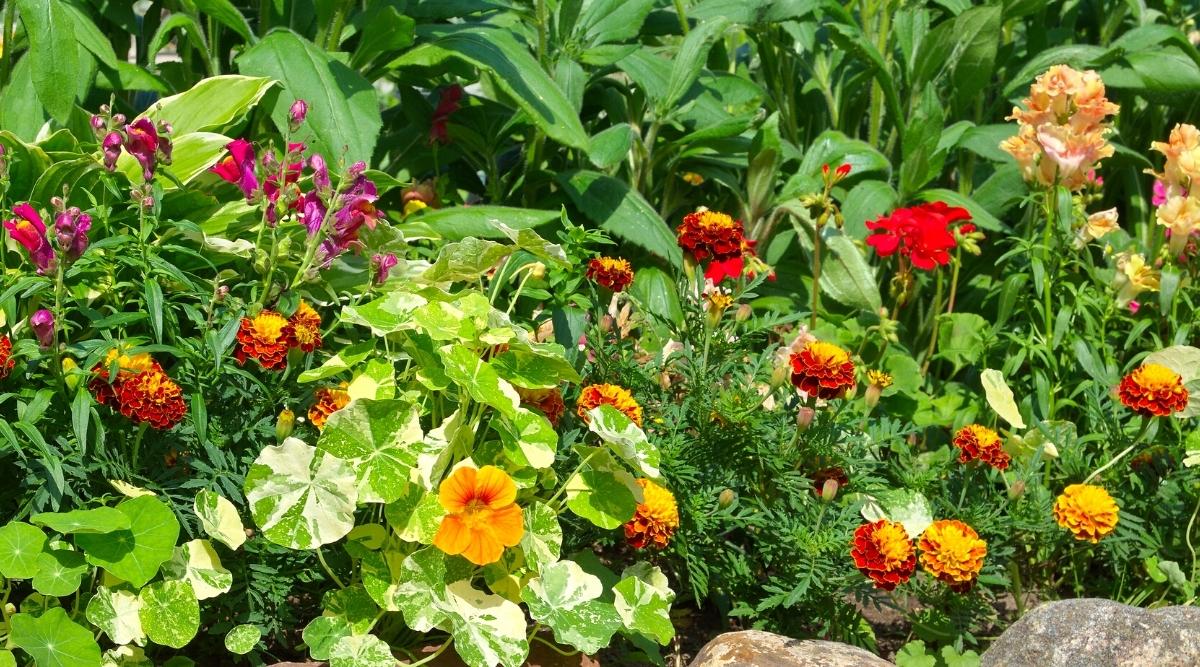

Companion planting is a very old gardening technique that involves pairing plants that will grow well together and even benefit from each other. Interplanting certain plants in between your vegetable rows or containers can increase biodiversity and is a great space saver! Let’s look at some benefits in detail.
Bees and other pollinating insects love marigold flowers. The bright yellows and oranges attract these pollinators and they can’t wait to dive right in. Attracting pollinators to your garden will help to keep those vegetable plants pollinated, as well as increase biodiversity in your area.
Marigolds have chemical compounds in their tissues that aid in repelling harmful insects. These chemical compounds are notorious for repelling worms known to attack tomatoes, peppers, and other veggies.
Marigolds attract ladybugs, hoverflies, and other beneficial insects that will help to control and eradicate the harmful ones.
Interplanting any crop can help save space. Marigolds are a neat, compact plant that will fit in almost any space!
Crops that are interplanted will help to reduce weed growth and maintain the soil surrounding your veggies. They will act as a ground cover, taking up more soil space and not allowing weeds to find their way in and take over.
Companion planting will conserve moisture and nutrients in the soil by keeping root systems insulated and protected. Marigolds are not heavy feeders, meaning they do not require many nutrients past what is found in regular soil. They will not try to uptake more than they need, which will leave nutrients in the soil for the surrounding plants or veggies.
Mistakes to Avoid
The wide range of benefits your garden can get from companion planting can dissipate if mistakes are made. Thankfully, these mistakes are avoidable and your marigolds can thrive in any garden when properly taken care of. Let’s look at each mistake that should be avoided when companion planting with marigolds.
All plants require a certain amount of space to grow and thrive in their location. Before planting, consider the space you have allotted and take into account the mature size the crops will be. You don’t want to plant crops too close as this can choke them out and even hinder fruit production in vegetables.
Marigolds are not heavy feeders, meaning they have very low fertility requirements. If planting with a crop that requires frequent replenishment of nutrients, note that this will bleed into other crops and cause some plants to go gangbusters if they are fed more than needed.
Some plants require full sun, while others do best in shade or part shade. Be sure to plant crops that share sunlight requirements near each other. An alternative to this would be to plant a taller crop to strategically create shade for a surrounding plant.
27 Companion Plants for Marigolds
Many plants pair well with marigolds, but let’s talk about which plants perform the best when planted next to them. We’ve broken this list up to discuss the most popular vegetable, herb, and flower pairings with garden marigolds.
Vegetable Companions
Planting marigolds with vegetables has many benefits, from attracting beneficial insects to deterring pests and adding biodiversity. See which vegetables prosper from having marigolds planted nearby.
Cucumbers


Growing cucumbers in your garden can be quite rewarding. Fresh veggies in the heat of summer is always a rewarding thing after all your hard work. Cucumbers can take over a lot of space in the garden if you let them.
Growing cucumbers on a trellis or fence can save you tons of space and give you more room for planting other veggies or flowers. Interplanting marigolds along trellised cucumbers or on the border of your plant can help your cucumber plants from relentless insects during the season.
Fresh veggies, space saver.
Cucumber seeds should be started indoors before early spring. There are so many varieties of cucumbers available, so be sure to research your variety to ensure you give it plenty of room to grow.
Tomatoes


Growing tomatoes can be both fun and easy if they get enough sun and have room to grow. These full sun crops will produce bountiful harvests if grown correctly.
They are prone to a few pests, so companion planting them with marigolds can be a great way to prevent these bugs from destroying your plants. Marigolds also attract plenty of pollinators so this will help to pollinate your tomatoes and ensure a fruitful harvest.
Fresh tomatoes, space saver.
Start seeds indoors two weeks before your last frost date. Transplants are available at local garden centers, so many varieties! Plant tomatoes in full sun where they will have plenty of space to grow (usually 36 inches on either side).
Squash


When spring kicks off, gardeners jump into gear excited for the midsummer harvests and colors. Often an afterthought, planting in late spring to midsummer can bring you harvests when planting certain crops.
Squash loves the warmer months and will mature in late fall in bountiful harvests. They are prone to a few pesky insects and critters, and marigolds can help you combat that. Marigolds will help to deter harmful insects as well as attract pollinators that will help your squash plants.
Late season veggies, attract pollinators.
Sow your seeds or transplant your squash into the ground with a generous amount of space. Squash will grow as large as five feet wide! Trellising squash can save you loads of garden space and act as shade if needed.
Carrots
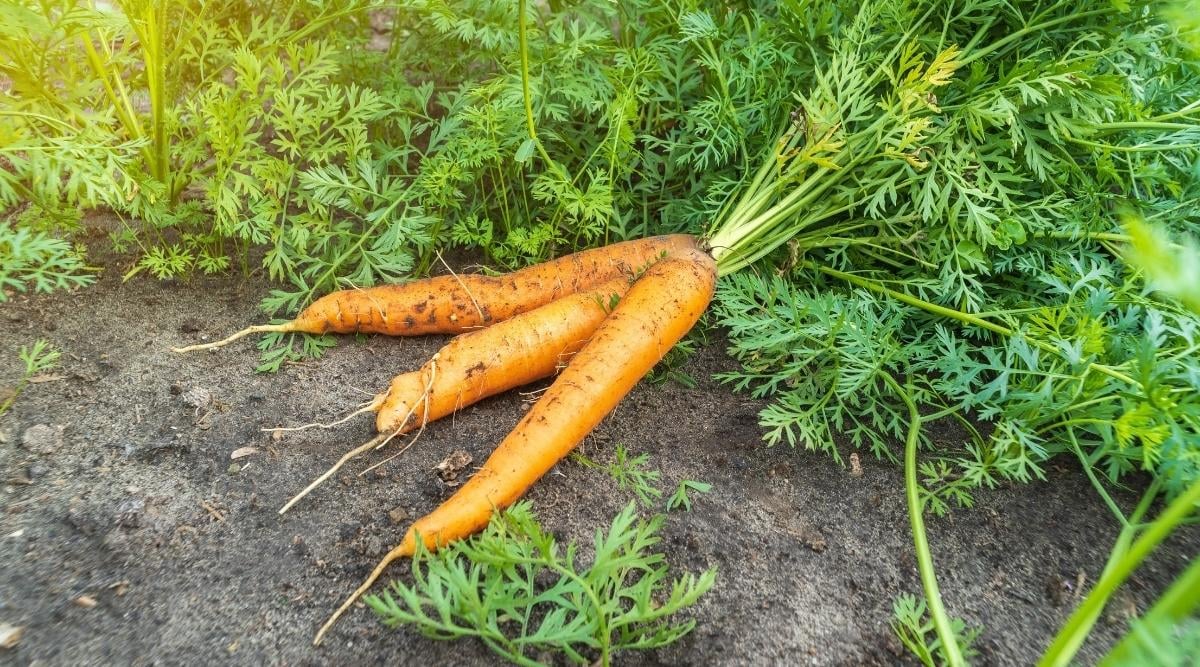

Carrots are such an easy crop to grow at home, and harvesting these root crops helps to loosen soil and acts as a form of aeration.
Interplanting carrots and marigolds will really aid the soil texture and won’t absorb an excessive amount of nutrients whilst doing so. Marigolds have shallow root systems so the carrots won’t be competing for nutrients.
Helps to loosen soil, space saving crop.
Carrot seeds can be sown in early spring as they are able to germinate in cooler temperatures. There are tons of varieties out there so look for additional sowing information on your seed packets. Most carrots will need to be thinned following germination.
Radishes


Interplanting rows of radishes with another crop or flower can prevent weed growth, add biodiversity, and aid in loosening the soil. All of this helps radishes mature properly.
Marigolds can be a great choice to plant in between your radishes. They will attract pollinators for your other crops. they also won’t take all the nutrients from your radishes since they have shallow root systems.
Biodiversity, break up soil, and weed prevention.
Seed rows of radishes in early spring. Once they have germinated, be sure to thin them out at least 3 inches apart – keep in mind this can vary depending on which variety you are planting. Plant marigolds in between rows of radish crops for maximum benefits.
Lettuce


Since lettuce can produce multiple harvests, interplanting between rows can be a great way to prevent bugs and other critters from harming the plants. Marigolds can deter slugs, beetles, and other critters from destroying your lettuce ensuring a bountiful harvest all summer long.
The best part, lettuce is fairly easy to grow and care of. It does not require much water, fertilizer, or any maintaining. the shade from marigolds can also help cool off the lettuce in the hot summer sun.
Deter pests and add biodiversity.
Seed rows of lettuce and rows of marigolds parallel to each other. If container planting, make sure each plant has enough room to grow – base this off of mature size for each plant.
Potatoes


Potatoes are a full sun crop that can take quite a bit of time to mature depending on the variety. Marigolds can help deter beetles and even rabbits from your potato leaves and won’t take up too many nutrients, leaving them for the potatoes.
In addition, marigolds produce a compound into the soil that helps deter root knot nematodes that can charm the potatoes. With fewer pests and a low risk of blemishes or damage to the potatoes, marigolds and potatoes pair well in the garden.
Deter pests and add biodiversity.
Potatoes do grow fairly tall, so make sure marigold rows are planted on the south side of potato rows so they aren’t shaded when the potatoes become tall and bushy.
Broccoli
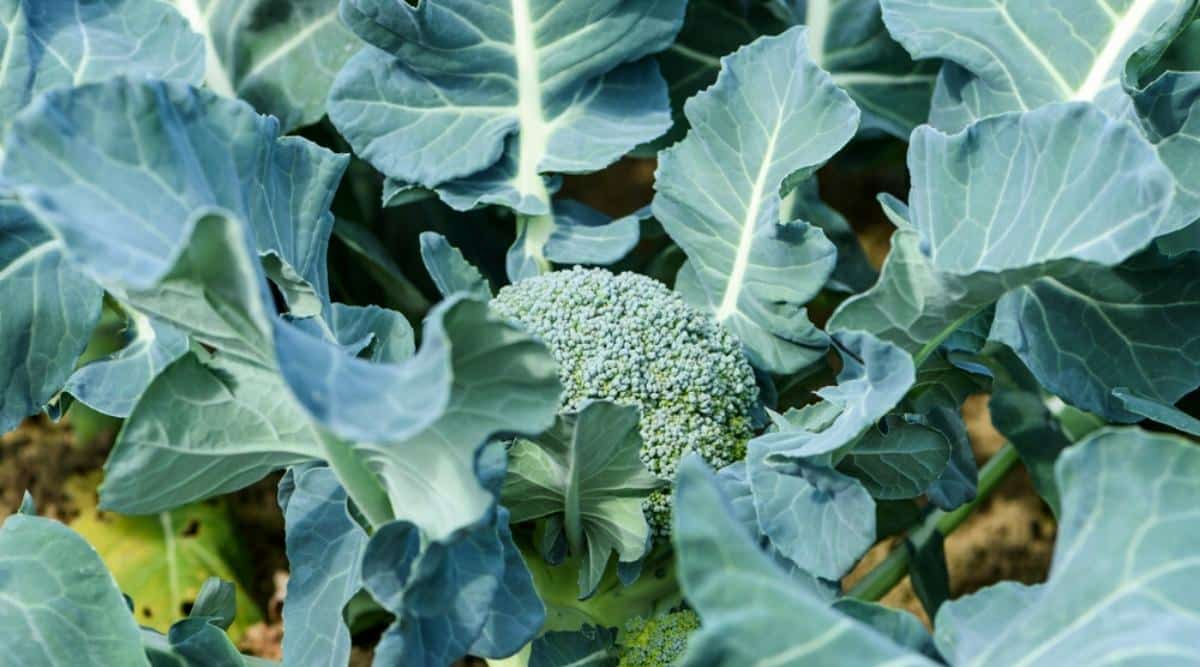

Broccoli is another crop that can benefit from the pest repellent qualities of marigolds. Plant marigolds around broccoli or in between rows to help keep the harmful beetles and caterpillars away.
Calcium is a necessary nutrient in the soil for growing broccoli. Thankfully, marigolds do not need much calcium so they do not compete for nutrients when planted with broccoli.
Deter pests from eating leaves.
Be sure to plant marigolds at least a foot away from your broccoli as it will be fairly large at its mature size.
Herb Companions
Nothing beats fresh herbs in the kitchen! Thankfully, herbs are easy to grow in the garden. Marigolds grow excellently next to so many herbs and help them grow, keeping your kitchen fully stocked with all the right seasonal herbs to enjoy.
Basil


Grown primarily for its culinary purposes, basil smells amazing. There are so many varieties of basil available, and they can be grown easily from seed. Basil is easy to grow, and also makes a great fall crop.
Basil does great in heat and makes a good addition to most gardens or raised beds. Pairing your basil with marigolds can prevent slugs and snails from harming your basil, especially in the rainy months.
Basil seeds can be sown indoors before the last frost or transplanted into fertile, well-draining soil.
Lavender


Companion planting with multiple insect-repelling crops can create a barrier for your other susceptible crops. Lavender pairs well with marigolds in the garden as they are both simple to establish and neither require much maintenance.
Lavender repels harmful insects and the bright purple blooms attract pollinators and other beneficial insects. Like marigolds, lavender can also grow quite well in all soil types. Planting lavender and marigolds make quite the insect barrier and can help protect your tomatoes, peppers, or other edible plants.
Repels harmful insects, attracts pollinators, and culinary purposes.
Sage


Sage is a tough herb to grow. It grows best in full sun but can handle partial sun and even poor soils. Sage can add texture to plantings and is a great culinary herb known for its delicious aroma.
Adding marigolds around areas where sage is planted can help prevent certain insects from harming your sage: such as aphids, spider mites, and slugs or snails. Sage can also thrive in hot climates, as long as it is planted in sandy, well-draining soil.
Culinary use, aromatic, tolerates heat and poor soil.
Sage will grow best in full sun, but can handle partial sun. Sage can be planted in garden borders or between certain crops where other plants might not tolerate the shade.
Oregano


Commonly grown in herb gardens, oregano is a very aromatic, compact growing herb that is great for cooking. It also makes a great companion plant for other plants from herbs, vegetables, and flowers.
It can attracts beneficial insects such as lacewings and hoverflies. These beneficial insects will eat the bad insects. You can create a harmful insect barrier by planting oregano and marigolds around the more susceptible crops.
Attract pollinators, beneficial insects, and culinary uses.
Plant oregano in full sun, keep flowers removed to promote herbaceous growth.
Thyme


Thyme is another great option to pair with marigolds in order to create a bad insect barrier. This aromatic herb is a low-growing, full sun crop that attracts the good bugs, but repels the bad ones.
Together marigolds and thyme make quite the combination and can protect other herbs or veggies from harmful insects. Plant thyme as a border, or along the edges of the flower bed for best results.
Repels harmful insects and culinary uses.
Plant thyme in well draining soil with ample space. Thyme is a low growing crop, so make sure it won’t be too shaded in its new area.
Dill


Dill is prone to a lot of pesky critters like caterpillars, rabbits, and slugs. Planting marigolds with or around your dill plants can help deter these pests from destroying your dill and keeping you from making those homemade pickles!
Just be careful as to what else you add in the garden with dill. It is known to stunt the growth of some other vegetables, such as carrots and eggplant.
Biodiversity and deter harmful insects.
Plant dill in a location that receives full sun. Plant marigolds alongside or around dill – allow about 10 inches in between each plant to allow them to grow.
Flower Companions
The vibrant colors of marigolds compliment many other colorful flowers when planted together in a flower bed or garden. Many flowers are susceptible to pests that marigolds are known to deter, so planting them with marigolds can be beneficial.
Salvia


Growing salvia along with marigolds can add a pop of color to your containers or gardens. The key to pairing flower companions is ensuring they have similar requirements and enough space to grow.
Salvia and marigolds both love the heat and sun, and will both bloom all season attracting loads of pollinators to your garden. Try planting the marigolds along the edge of the bed with salvia farther back to create height and definition in the landscape!
Attract pollinators and have fresh cut flowers all summer long.
There are many varieties of Salvia out there, all sun-loving flowers. Plant Salvia at least 18” away from other crops. Keep spent Salvia blooms deadheaded to promote flowering all season long.
Bachelor’s Buttons


These pretty pops of color also go by cornflower. They look stunning next to marigolds in the garden with their complementary colors. They most often come in the classic “cornflower blue” color, but you can also find them in shades of red pink, and white.
Planting bachelor buttons with marigolds can have positive effects on the garden. More than just eye-catching appeal, they attract pollinators to the garden. The flowers bloom nonstop in the summer heat and they can tolerate most soil conditions.
Attract pollinators and beneficial insects.
Direct seed bachelor’s buttons about 12-18” from marigolds or in large clumps on the borders of flower beds. Allow them to self-sow and come back year after year without risk of them taking over your garden.
Lantana


Native to areas with warmer climates, lantana is one of the most heat tolerant plants you can get your hands on. The flowers attract pollinators and make great additions to borders and mixed containers.
Lantana and marigolds don’t benefit from each other necessarily, but they make great color combinations and can withstand the driest and hottest months. A garden is much easier to maintain when the plants have similar needs.
Heat tolerant, attracts pollinators, and aromatic.
Plant Lantana in areas that receive full sun, or where your other plants seem to fry. In warmer climates these plants can survive winter, but in cooler climates they are annuals.
Zinnias


Brightly-colored zinnias are notorious for their ability to withstand drought and the hot summer months. Marigolds and zinnias make great color combinations with all of their strikingly vivid bloom colors and last all season long!
Zinnias don’t necessarily benefit from being planted with or near marigolds, but they make quite a striking color display and attract loads of pollinators. They are also both super heat and drought tolerant.
Attract pollinators and fresh cut flowers.
There are so many varieties of zinnias, you can start them from seed or find transplants available at local garden centers. Seeds should be sown indoors two weeks before your last frost date, as they are tender to cool temperatures. Plant zinnias at least 12 inches away from other crops.
Geraniums


Geraniums are one of the most popular annuals, with good reason. They are so low maintenance and grow in full sun or partial shade. With frequent deadheading, you can have prolifically blooming plants all season long.
Marigolds repel slugs in the garden, which may want to feast on geraniums. Both flowers are universal companion plants that share many of the same benefits in the garden. They make great companion plants for just about any crop, including each other.
Cut flowers and heat tolerant.
Geraniums can be planted in early spring and will grow all season long. Keep plants deadheaded to encourage blooming.
Nasturtium


Marigolds are known to bloom all season, but they can still have lull periods from time to time. Nasturtium is a prolific bloomer, and can be a great way to always have a flowering plant in your garden.
These plants can grow in clumps, some are known to vine, and they are entirely edible – making them a great option for a veggie garden.They are also known to repel harmful insects and attract pollinators and other beneficial insects.
Prolific bloomers, edible leaves u0026amp; flowers, and attracts beneficial insects.
Alyssum


One of the biggest pollinator attractors is alyssum, also known as sweet alyssum. The small purple and white flowers provide color and an aromatic scent all summer long. Plant them next to cheery marigolds and you’ll also have a happy aesthetic.
Sweet alyssum grows close to the ground – only about 3-9 inches tall. This alone has its own benefits, including retaining water as mulch would. Sweet alyssum thrives very well in hot climates, just be sure it isn’t on the invasive species list in your state before planting!
Attract pollinators and other beneficial insects, aromatic.
Plant alyssum in early spring as a container or garden border. Alyssum has a compact growing habit, so it only needs around 8-10 inches of room.
Snapdragon


Snapdragons are another very popular plant amongst home gardeners. They can tolerate cooler temperatures, as well as warmer temperatures. There are so many flower colors and their upright growing habit makes them a great companion plant. You can plant them with almost anything as long as they receive enough sun and will bloom prolifically!
While snapdragons don’t really reap any monumental benefits from being planted alongside or with marigolds, the two will make great container or patio pot friends. Snapdragons will look great in the middle of a container as the main focal point, or in the backs of landscapes with a marigold border.
Cut flowers, container planting, attract pollinators and other beneficial insects.
Snapdragons are one of the earliest plants you can purchase in spring at a garden center. Plant them in a location that receives full sun and they will bloom prolifically! Harvest the flowers for vases or arrangements. Most snapdragons will need at least 10 inches of space but there are smaller varieties that have a more compact growing habit.
Vinca
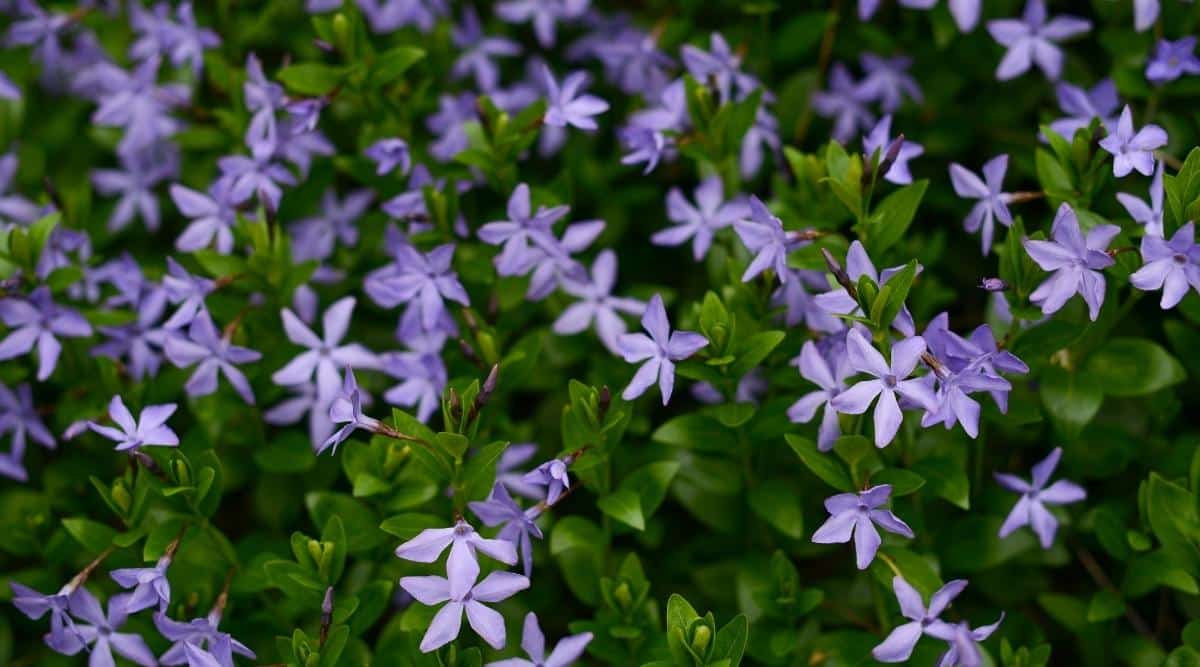

There are a few plants that are commonly referred to as ‘vinca’. The annual flowering vinca is a great option to plant with your other full sun and drought tolerant plants. Vinca does so well in that hot summer sun and can handle periods of drought.
The bright blooms make them hard to miss in landscapes and containers. They bloom non-stop from early on in the summer all the way through fall.
Vinca is very sensitive to cold, therefore planting it in late spring or early summer is the best way to go. Vinca is drought tolerant, and actually prefers to be grown where its given dry spells. Plant Vinca in soil that drains well to ensure it does not stay too moist.
Calendula


Otherwise known as ‘the pot marigold’, calendula makes a great companion for marigolds or any other full sun plant. They are very low maintenance, heat-loving annuals that attract pollinators and provide bright blooms all season long.
Calendula is often mistaken for marigolds, but they are two completely different plants. There are many herbal uses for calendula that marigolds don’t possess. They bloom in similar colors like orange and yellow.
Medicinal purposes and attract pollinators.
Seeds can be found at your local nursery, sow them indoors in early spring, or sow them directly into containers or the ground once danger of frost has passed. Calendula is very low maintenance and super easy going!
Petunias


One of the most popular flowering annuals is the petunia. There are so many colors, sizes, and kinds of petunias! Petunias are a great plant in any full sun situation, and can fill a space easily with minimal maintenance.
Most Petunias benefit from deadheading, but there are varieties available that do not require this tedious yet beneficial task! Petunias don’t directly benefit from marigolds as a companion, but they make a great pair.
Petunias are heavy feeders, and marigolds are not. Therefore when planting the two together, the petunias won’t be fighting for nutrients since the marigolds won’t be using as much. They also look super pretty when planted together!
Attract pollinators, fill space, and deer resistant.
Petunias can be planted in early spring and are generally found as transplants at garden centers.
Verbena
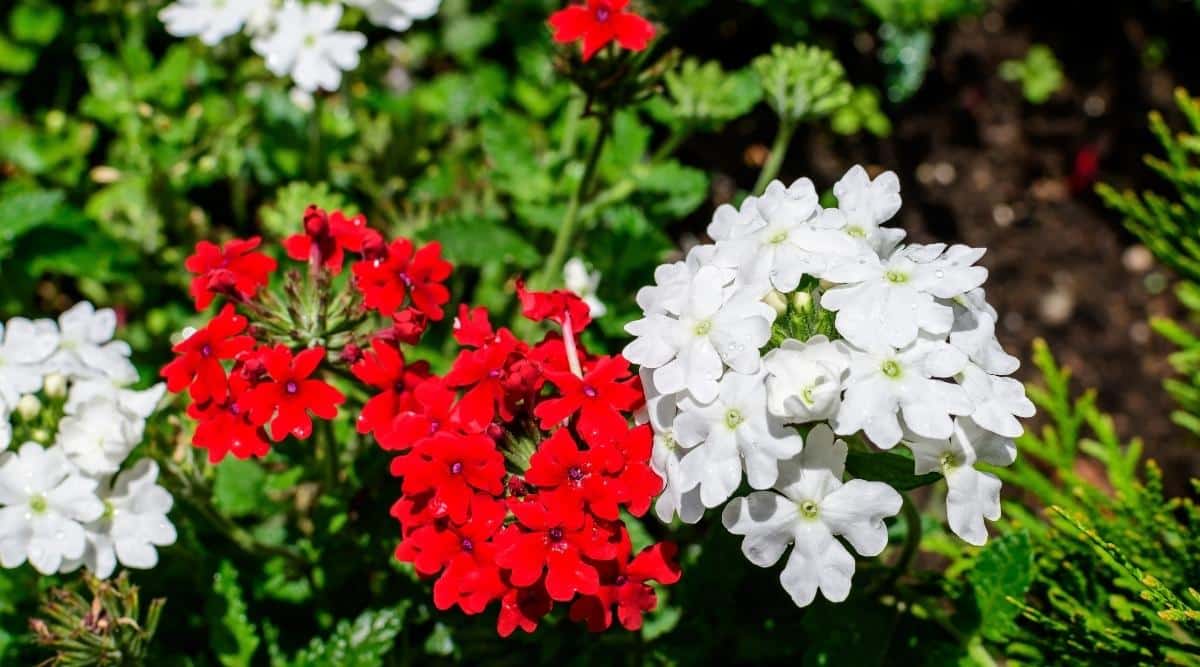

Often confused with lantana, verbena is a low-growing annual flower that does great in the heat and comes in just about every color you can think of. Many of which pair nicely with the bright colors of marigold blossoms.
Verbena is a great plant for containers or filling a space where a low to the ground plant is desired. They benefit from frequent deadheading, although this is pertinent to keep the plant healthy.
Attract pollinators and low to the ground.
Pick up transplants at your garden center, give verbena at least 10 inches of space to get the best results.
Strawflower


One of my favorite plants, and usually underrated, are strawflowers. Strawflowers bloom in spiky, daisy-like flowers that are crunchy in texture. These alien looking flowers do so well in the warm summer months and are drought resistant.
Strawflowers and marigolds don’t benefit from each other persay. But they are both such low maintenance, easy going plants they are almost destined to be together.
Drought tolerant and attract pollinators.
Seeds can sometimes be found at nurseries although they can be hard to come by. Plant transplants at least 10 inches apart to ensure they have enough room to grow.
Frequently Asked Questions
All marigold varieties will make great companion plants for any of the plants listed above. However, research shows that the french marigolds are more potent in their insect repelling compounds. Therefore, if you are looking to plant marigolds to deter certain insects, french marigolds will be the best option for you!
Marigolds are a true flowering annual, meaning the plant itself will not survive the winter. However, marigolds are known to reseed themselves given the right environment. They do not have an aggressive growth habit so they won’t go bonkers and take over large areas, but you may see them pop up in spring.
Marigolds require full sun (6-8 hours) daily. If your marigolds aren’t blooming, it is possible they aren’t receiving enough sunlight.
Final Thoughts
Marigolds can be a great companion plant for almost any other plant or crop that also enjoys full sun, heat, and has similar watering requirements. But, as with all plants, there are a few things to keep in mind.
Things to Remember
- Give marigolds and their companions ample space.
- Don’t plant marigolds in an area where they will get too much shade.
- Plant marigolds after danger of frost has passed, usually late spring.
- Just because they are pest repellent, marigolds aren’t indestructible plants.
Marigolds are easy-going, low-maintenance flowers that can also benefit certain plants in your garden, as long as you have proper expectations. From pest control properties to their beautiful orange and yellow blooms, there’s no reason not to add a few marigolds to your vegetable or flower garden this season!
[ad_2]
Source link
